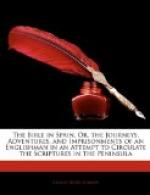We slept at Ribida de Sela, and the next day, at noon, arrived at Llanes. Our route lay between the coast and an immense range of mountains, which rose up like huge ramparts at about a league’s distance from the sea. The ground over which we passed was tolerably level, and seemingly well cultivated. There was no lack of vines and trees, whilst at short intervals rose the cortijos of the proprietors,—square stone buildings surrounded with an outer wall. Llanes is an old town, formerly of considerable strength. In its neighbourhood is the convent of San Cilorio, one of the largest monastic edifices in all Spain. It is now deserted, and stands lone and desolate upon one of the peninsulas of the Cantabrian shore. Leaving Llanes, we soon entered one of the most dreary and barren regions imaginable, a region of rock and stone, where neither grass nor trees were to be seen. Night overtook us in these places. We wandered on, however, until we reached a small village, termed Santo Colombo. Here we passed the night, in the house of a carabineer of the revenue, a tall athletic figure who met us at the gate armed with a gun. He was a Castilian, and with all that ceremonious formality and grave politeness for which his countrymen were at one time so celebrated. He chid his wife for conversing with her handmaid about the concerns of the house before us. “Barbara,” said he, “this is not conversation calculated to interest the strange cavaliers; hold your peace, or go aside with the muchacha.” In the morning he refused any remuneration for his hospitality. “I am a caballero,” said he, “even as yourselves. It is not my custom to admit people into my house for the sake of lucre. I received you because you were benighted and the posada distant.”
Rising early in the morning, we pursued our way through a country equally stony and dreary as that which we had entered upon the preceding day. In about four hours we reached San Vincente, a large dilapidated town, chiefly inhabited by miserable fishermen. It retains, however, many remarkable relics of former magnificence: the bridge, which bestrides the broad and deep firth, on which stands the town, has no less than thirty-two arches, and is built of grey granite. It is very ancient, and in some part in so ruinous a condition as to be dangerous.
Leaving San Vincente behind us, we travelled for some leagues on the sea-shore, crossing occasionally a narrow inlet or firth. The country at last began to improve, and in the neighbourhood of Santillana was both beautiful and fertile. About a league before we reached the country of Gil Blas, we passed through an extensive wood, in which were rocks and precipices; it was exactly such a place as that in which the cave of Rolando was situated, as described in the novel. This wood has an evil name, and our guide informed us that robberies were occasionally committed in it. No adventure, however, befell us, and we reached Santillana at about six in the evening.




